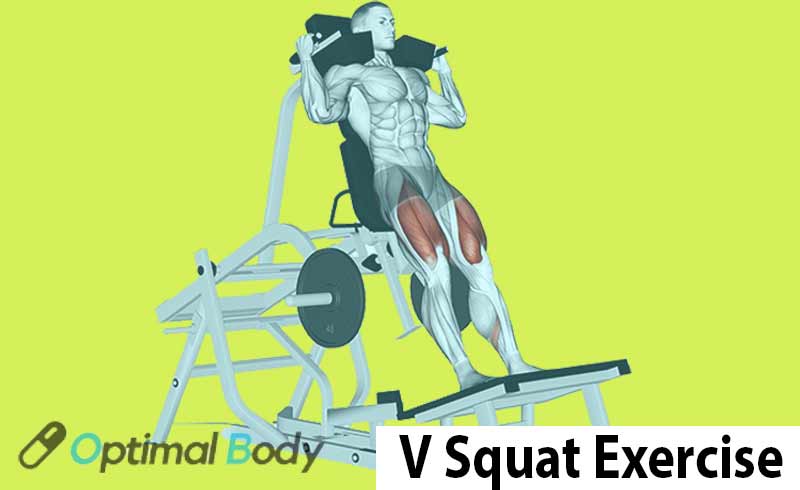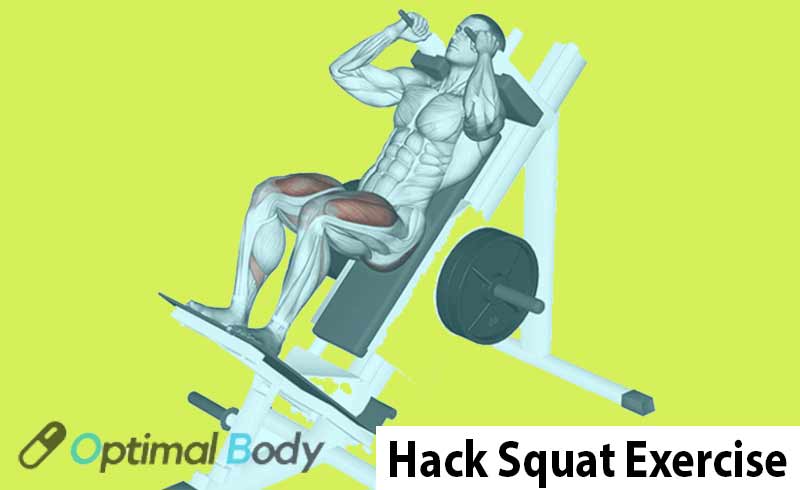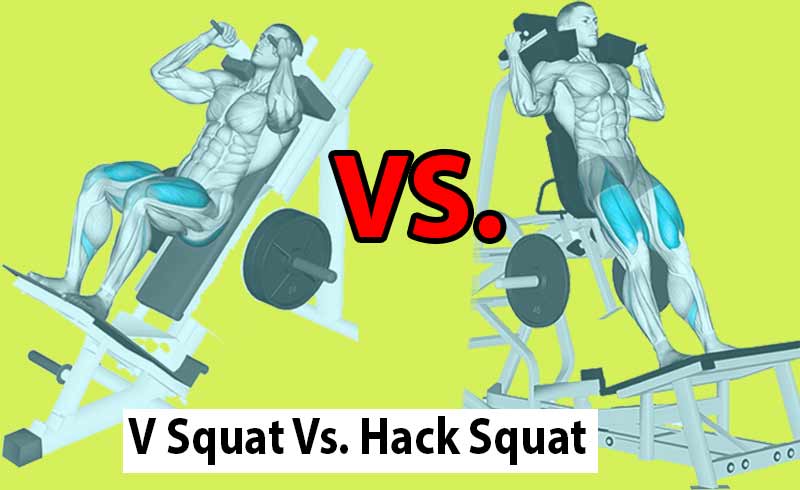On leg day, squats are the go-to exercise for developing powerful thighs and isolating the quadriceps. But did you know that there are various squat variations that can do to grow your legs?
The V squat Vs hack squat are fantastic options for adding diversity and targeting your quadriceps in different ways.
In this exercise comparison, we’ll discuss in-depth:
- V squat benefits
- Hack squat benefits
- Hack Squat vs. V Squat: Similarities and differences
- Which one is the best for bigger legs?
Quick Answer:
| Specs | V Squat | Hack Squat |
|---|---|---|
| Target Muscles | Quadriceps, Glutes | Quadriceps |
| Machine Type | V Squat Machine | Hack Squat Machine |
| Stance | Wider, V shape | Shoulder-width, slight outward toe angle |
| Secondary Muscles Worked | Calves, Lower Back, Hamstrings | Calves, Lower Back, Hamstrings |
| Movement Path | Arc | Straight Line |
| Knee Strain Risk | Lower | Higher |
| Benefits | Improved Hip Mobility, Glute Engagement | Intense Quadriceps Focus, Reduced Lower Back Strain |
| Recommended for: | Those seeking a more balanced lower body workout | Those focused on building massive quads |
| Machine Stability | Stable and Supportive | Stable and Supportive |
Related Comparison: The Difference Between Barbell and Dumbbell Squats
V Squat Vs. Hack Squat: Key Similarities
1. Target Muscle Groups:
The primary focus of both V squats and hack squats is on the quadriceps, those large muscles on the front of your thighs responsible for extending your knees.
2. Use of Machines:
Both exercises employ specially-designed machines that provide stability and support during the movement.
These machines allow you to concentrate on working your quadriceps without worrying about balance and stabilization.
3. Muscles Worked:
While the main emphasis is on the quadriceps, both V squats and hack squats engage secondary muscles like the calves, lower back, and hamstrings to some extent.
This engagement provides added support during the exercise.
4. Range of Motion:
Though the two exercises have different execution patterns, they share similar motion pathways. This means that if you’ve been performing standard squats, you’re likely well-prepared for the V squat and hack squat movements.
4. Work and Rest:
Both exercises have a similar approach to sets and reps.
For muscle size, aim for 3 to 5 sets of around 10 repetitions with 1 to 2 minutes of rest between sets.
If you’re focusing on pure strength, opt for heavier weights and do a maximum of 5 reps for the same sets, with double the rest time.
Hack Squat vs. V Squat: Main Differences
1. Equipment Type:
Hack squats are commonly performed on an inclined machine, designed to place your body at an angle of around 45 degrees.
This angle isolates the quadriceps even further and reduces strain on the lower back.
V squats, on the other hand, utilize a machine that allows for a parabolic motion, pushing your body outward rather than following a straight line.
2. Stance:
When performing hack squats, your legs are generally aligned with your shoulders, and your feet point slightly outward.
In contrast, V squats require a wider stance, forming an upside-down V shape with your legs, and your feet are positioned at a more obtuse angle. This change in stance alters muscle recruitment during the exercise.
3. Secondary Muscles Targeted:
While hack squats primarily target the quadriceps, V squats engage the glutes in addition to the quadriceps, this dual muscle targeting offers a more balanced workout for your lower body.
4. Path of Movement:
The path of movement differs between the two exercises.
Hack squats follow a straight line, providing a controlled up-and-down motion.
V squats, on the other hand, offer a more arched path, giving your legs a different challenge during the exercise.
5. Knee Pain:
Due to the limited hip flexion in hack squats, there may be more strain on the knees, making it less suitable for individuals with knee issues.
V squats, with their increased hip flexion, are generally considered a safer option for those with knee concerns.
How to Choose Between V Squat and Hack Squat
When deciding between V squats and hack squats, consider the following factors:
- Training Goals: Determine which muscle groups you want to prioritize. If your main focus is building massive quads, hack squats are an excellent choice.
On the other hand, if you seek a more balanced leg workout that engages multiple lower body muscles, V squats may be the better option. - Physical Ability: Assess your joint health and mobility. Choose the exercise that aligns well with your capabilities and minimizes discomfort.
- Muscle Fatigue: Consider the current state of your leg muscles. If certain muscle groups are still recovering from previous workouts, opt for the exercise that targets fresher muscles.
- Personal Preference: Pay attention to how each exercise feels to your body. Choose the one that feels more natural and comfortable, as this will likely improve your overall performance.
Benefits of V Squat

The V squat offers several unique benefits that may make it the preferred choice for some gym-goers:
- Improved Hip Mobility: The wider stance and increased hip flexion in V squats promote better hip mobility. This can be particularly beneficial for individuals with sedentary lifestyles or hip mobility issues.
- Glute Engagement: By targeting the glutes in addition to the quadriceps, V squats provide a more comprehensive lower body workout. Strengthening the glutes can enhance overall lower body strength and stability.
- Less Strain on the Knees: The natural range of motion in V squats puts less strain on the knees compared to hack squats. V squats are thus a safer option for people who have knee problems.
Benefits of Hack Squat

While V squats have their advantages, hack squats have more benefits that make them a good exercise:
- Intense Quadriceps Focus: Hack squats isolate the quadriceps more than V squats, making them an effective tool for bulking up the quads.
- Reduced Lower Back Strain: The inclined position in hack squats minimizes lower back engagement, making it a safer option for individuals with lower back issues.
- Stability and Support: Hack squat machines provide excellent stability and support during the exercise, allowing you to lift heavy weights safely and effectively.
References and Sources:
- Drinkwater EJ, Pritchett EJ, Behm DG. Effect of instability and resistance on unintentional squat-lifting kinetics. Int J Sports Physiol Perform. 2007 Dec;2(4):400-13. doi: 10.1123/ijspp.2.4.400. PMID: 19171958.
- Cohen, J. W., Lee, P., & Buchman-Pearle, J. (2017). The Effects of Footwear on Squat Movements. Western Undergraduate Research Journal: Health and Natural Sciences, 8(1). https://doi.org/10.5206/wurjhns.2017-18.29
- Decker, Mike & Krong, Jake & Peterson, Daniel & Anstett, Tyler & Torry, Michael & Giphart, Erik & Shelburne, Kevin & Philippon, Marc. (2009). DEEP HIP MUSCLE ACTIVATION DURING A SQUAT EXERCISE.
- Fry AC, Smith JC, Schilling BK. Effect of knee position on hip and knee torques during the barbell squat. Journal of Strength and Conditioning Research. 2003 Nov;17(4):629-633. DOI: 10.1519/1533-4287(2003)017<0629:eokpoh>2.0.co;2. PMID: 14636100.
- Larsen, Stian & Kristiansen, Eirik & Helms, Eric & Tillaar, Roland. (2021). Effects of Stance Width and Barbell Placement on Kinematics, Kinetics, and Myoelectric Activity in Back Squats. Frontiers in Sports and Active Living. 3. 719013. 10.3389/fspor.2021.719013.
- Illmeier, Gabriel & Rechberger, Julian. (2023). The Limitations of Anterior Knee Displacement during Different Barbell Squat Techniques: A Comprehensive Review. Journal of Clinical Medicine. 12. 2955. 10.3390/jcm12082955.
- Bench Press Calculator - April 22, 2024
- Press to Handstand: Ultimate Step-by-Step Guide - April 22, 2024
- Cable Press (How To Do, Benefits, Targeted Muscles, Alternative) - April 22, 2024

